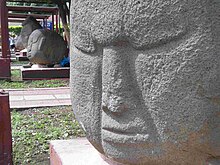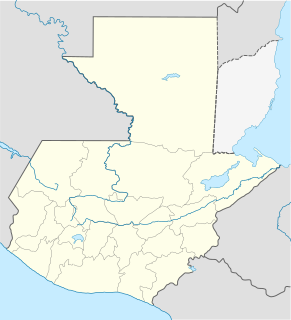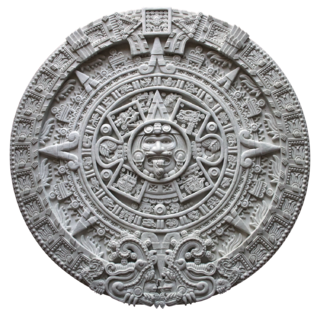
Kaminaljuyu is a Pre-Columbian site of the Maya civilization that was primarily occupied from 1500 BC to AD 1200. Kaminaljuyu has been described as one of the greatest of all archaeological sites in the New World by Michael Coe, although its remains today – a few mounds only – are far less impressive than other Maya sites more frequented by tourists. When first mapped scientifically, it comprised some 200 platforms and pyramidal mounds, at least half of which were created before the end of the Preclassic period. Debate continues about the size, scale, and degree by which, as an economic and political entity, it integrated both the immediate Valley of Guatemala and the Southern Maya area.

Tak'alik Ab'aj is a pre-Columbian archaeological site in Guatemala. It was formerly known as Abaj Takalik; its ancient name may have been Kooja. It is one of several Mesoamerican sites with both Olmec and Maya features. The site flourished in the Preclassic and Classic periods, from the 9th century BC through to at least the 10th century AD, and was an important centre of commerce, trading with Kaminaljuyu and Chocolá. Investigations have revealed that it is one of the largest sites with sculptured monuments on the Pacific coastal plain. Olmec-style sculptures include a possible colossal head, petroglyphs and others. The site has one of the greatest concentrations of Olmec-style sculpture outside of the Gulf of Mexico.
La Democracia is a municipality in the Escuintla department of Guatemala. It is most notable for the Olmec-influenced carved stone heads from the Monte Alto culture now on display around the town square. The town possesses a small archaeological museum, the Museo Regional de Arqueología de la Democracia.
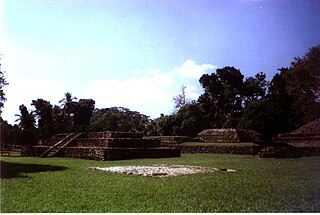
Izapa is a very large pre-Columbian archaeological site located in the Mexican state of Chiapas; it is best known for its occupation during the Late Formative period. The site is situated on the Izapa River, a tributary of the Suchiate River, near the base of the volcano Tacaná, the sixth tallest mountain in Mexico.

Cotzumalhuapa archaeological culture is from the piedmont area of the Escuintla Department, Guatemala. The Cotzumalhuapa archaeological zone is near the town of Santa Lucía Cotzumalguapa.

Tres Islas is a small pre-Columbian Maya archaeological site 20 kilometres (12 mi) north of Cancuen in Petén Department, northern Guatemala. The site has been dated to the Late Preclassic and Late Classic periods of Mesoamerican chronology. The main feature of the site is a group of three Maya stelae and an altar, arranged in a way that mimics an E-Group Maya astronomical complex.
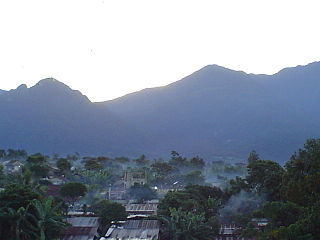
Chocolá is a Preclassic Southern Maya site whose developmental emphasis was from ca. 1000 BC to AD 200. The site lies within the Southern Maya area.

The site of Ujuxte is the largest Preclassic Maya site to be discovered on the Guatemalan Pacific coast. It is in the Retalhuleu Department, in western Guatemala.

Yaxha is a Mesoamerican archaeological site in the northeast of the Petén Basin region, and a former ceremonial centre and city of the pre-Columbian Maya civilization. Yaxha was the third largest city in the region and experienced its maximum power during the Early Classic period.

La Blanca is a pre-Columbian Mesoamerican archaeological site in present-day Retalhuleu Department, western Guatemala. It has an occupation dating predominantly from the Middle Preclassic period of Mesoamerican chronology. This site belongs to the later period of the Mokaya culture.

The Southern Maya Area (SMA) is a part of Mesoamerica, long believed important to the rise of Maya civilization, the period that is also known as Preclassic Maya. It lies within a broad arc or cantilevered rectangle from Chiapa de Corzo, in the Isthmus of Tehuantepec, in the northwest due south to Izapa and Paso de la Amada, from Chiapa de Corzo southeast to Copán, Honduras, and from Copán south to Chalchuapa, El Salvador.

El Tintal is a Maya archaeological site in the northern Petén region of Guatemala, about 25 kilometres (16 mi) northeast of the modern-day settlement of Carmelita, with settlement dating to the Preclassic and Classic periods. It is close to the better known sites of El Mirador, to which it was linked by causeway, and Nakbé. El Tintal is a sizeable site that includes some very large structures and it is one of the four largest sites in the northern Petén; it is the second largest site in the Mirador Basin, after El Mirador itself. El Tintal features monumental architecture dating to the Middle Preclassic similar to that found at El Mirador, Nakbé and Wakna. Potsherds recovered from the site date to the Late Preclassic and Early Classic periods, and construction continued at the site in the Late Classic period.
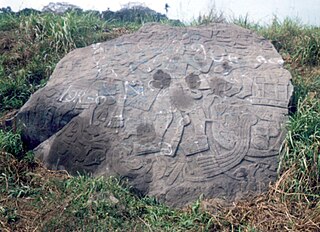
Bilbao is a Mesoamerican archaeological site about 1 mile (1.6 km) from the modern town of Santa Lucía Cotzumalguapa in the Escuintla department of Guatemala. The site lies among sugar plantations on the Pacific coastal plain and its principal phase of occupation is dated to the Classic Period. Bilbao was a major centre belonging to the Cotzumalhuapa culture with its main occupation dating to the Late Classic. Bilbao is the former name of the plantation on which the site lies and from which it has derived its name.

Balberta is a major Mesoamerican archaeological site on the Pacific coastal plain of southern Guatemala, belonging to the Maya civilization. It has been dated to the Early Classic period and is the only known major site on the Guatemalan Pacific coastal plain to have exposed Early Classic architecture that has not been buried under posterior Late Classic construction. The site was related to the nearby site of San Antonio, which lies 6 kilometres (3.7 mi) to the west.

The Preclassic period in Maya history stretches from the beginning of permanent village life c. 1000 BC. until the advent of the Classic Period c. 250 AD, and is subdivided into Early, Middle, and Late. Major archaeological sites of this period include Nakbe, Uaxactun, Seibal, San Bartolo, Cival, and El Mirador in Guatemala; Cahal Pech, Blackman Eddy, and Cerros in Belize; and Calakmul, Yaxnohcah, Ichkabal, Komchen, and Xocnaceh in Mexico.
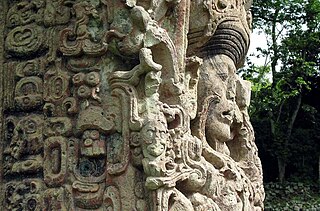
Maya stelae are monuments that were fashioned by the Maya civilization of ancient Mesoamerica. They consist of tall, sculpted stone shafts and are often associated with low circular stones referred to as altars, although their actual function is uncertain. Many stelae were sculpted in low relief, although plain monuments are found throughout the Maya region. The sculpting of these monuments spread throughout the Maya area during the Classic Period, and these pairings of sculpted stelae and circular altars are considered a hallmark of Classic Maya civilization. The earliest dated stela to have been found in situ in the Maya lowlands was recovered from the great city of Tikal in Guatemala. During the Classic Period almost every Maya kingdom in the southern lowlands raised stelae in its ceremonial centre.
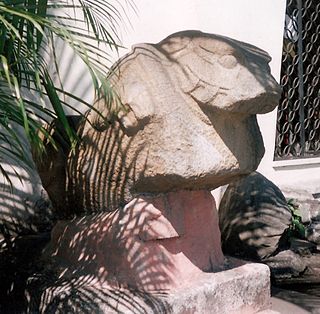
The Museo Regional de Arqueología de la Democracia is an archaeological museum in the municipality of La Democracia in the department of Escuintla in Guatemala. The museum displays pre-Columbian Mesoamerican artefacts from the Pacific lowlands datingfrom the Preclassic Period through to the Postclassic Period, with a particular emphasis upon the local Monte Alto culture. The museum is open from Tuesday through to Saturday from 8am to 4pm.

Regional communications in ancient Mesoamerica are believed to have been extensive. There were various trade routes attested since prehistoric times. In this article, especially the routes starting in the Mexico Central Plateau, and going down to the Pacific coast will be considered. These contacts then went on as far as Central America.

The history of Maya civilization is divided into three principal periods: the Preclassic, Classic and Postclassic periods; these were preceded by the Archaic Period, which saw the first settled villages and early developments in agriculture. Modern scholars regard these periods as arbitrary divisions of chronology of the Maya civilization, rather than indicative of cultural evolution or decadence. Definitions of the start and end dates of period spans can vary by as much as a century, depending on the author. The Preclassic lasted from approximately 2000 BC to approximately 250 AD; this was followed by the Classic, from 250 AD to roughly 950 AD, then by the Postclassic, from 950 AD to the middle of the 16th century. Each period is further subdivided:
Parsons, Lee A. 1976 Excavation of Monte Alto, Escuintla, Guatemala In Research Reports: Abstracts and Reviews of Research during the Year 1968. pp. 325–332 National Geographic Society, Washington, DC
Popenoe De Hatch, Marion 1989 A seriation of Monte Alto sculptures In New Frontiers in the Archaeology of the Pacific Coast of Southern Mesoamerica. Frederick Bove and Lynette Heller, eds. pp. 25–42 Anthropological Research Papers, 39 Arizona State University, Tempe



